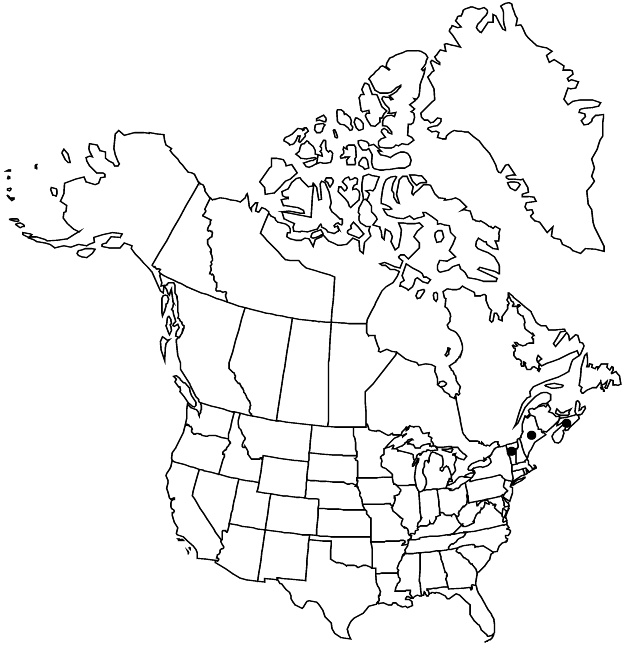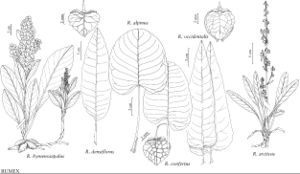Difference between revisions of "Rumex alpinus"
Sp. Pl. 1: 334. 1753.
FNA>Volume Importer |
imported>Volume Importer |
||
| (3 intermediate revisions by 2 users not shown) | |||
| Line 8: | Line 8: | ||
}} | }} | ||
|common_names=Monk’s-rhubarb;butter or Alpine dock | |common_names=Monk’s-rhubarb;butter or Alpine dock | ||
| + | |special_status={{Treatment/ID/Special_status | ||
| + | |code=I | ||
| + | |label=Introduced | ||
| + | }}{{Treatment/ID/Special_status | ||
| + | |code=F | ||
| + | |label=Illustrated | ||
| + | }} | ||
|basionyms= | |basionyms= | ||
|synonyms= | |synonyms= | ||
| Line 24: | Line 31: | ||
|elevation=0-1500 m | |elevation=0-1500 m | ||
|distribution=N.S.;Maine;Vt.;c;s Europe;w Asia. | |distribution=N.S.;Maine;Vt.;c;s Europe;w Asia. | ||
| + | |introduced=true | ||
|discussion=<p><i>Rumex alpinus</i> belongs to subsect. Alpini Rechinger f. The name <i>R. alpinus</i> has been proposed for nomenclatural conservation (S. Cafferty and S. Snogerup 2000).</p><!-- | |discussion=<p><i>Rumex alpinus</i> belongs to subsect. Alpini Rechinger f. The name <i>R. alpinus</i> has been proposed for nomenclatural conservation (S. Cafferty and S. Snogerup 2000).</p><!-- | ||
--><p>This species was first reported from North America in Nova Scotia (M. L. Fernald 1921; K. H. Rechinger 1937). It remains uncommon in the United States and Canada. <i>Rumex alpinus</i> never has been reported as being a serious invasive weed; however, it may persist at a site for a very long time. Previously, the species was cultivated widely, mostly for medicinal and veterinary purposes.</p> | --><p>This species was first reported from North America in Nova Scotia (M. L. Fernald 1921; K. H. Rechinger 1937). It remains uncommon in the United States and Canada. <i>Rumex alpinus</i> never has been reported as being a serious invasive weed; however, it may persist at a site for a very long time. Previously, the species was cultivated widely, mostly for medicinal and veterinary purposes.</p> | ||
| Line 34: | Line 42: | ||
-->{{#Taxon: | -->{{#Taxon: | ||
name=Rumex alpinus | name=Rumex alpinus | ||
| − | |||
|authority=Linnaeus | |authority=Linnaeus | ||
|rank=species | |rank=species | ||
| Line 49: | Line 56: | ||
|publication title=Sp. Pl. | |publication title=Sp. Pl. | ||
|publication year=1753 | |publication year=1753 | ||
| − | |special status= | + | |special status=Introduced;Illustrated |
| − | |source xml=https:// | + | |source xml=https://bitbucket.org/aafc-mbb/fna-data-curation/src/2e0870ddd59836b60bcf96646a41e87ea5a5943a/coarse_grained_fna_xml/V5/V5_1061.xml |
|subfamily=Polygonaceae subfam. Polygonoideae | |subfamily=Polygonaceae subfam. Polygonoideae | ||
|genus=Rumex | |genus=Rumex | ||
Latest revision as of 22:07, 5 November 2020
Plants perennial, glabrous or minutely papillose-pubescent, with stout, creeping rhizome. Stems erect, branched above middle, 60–100 cm. Leaves: ocrea mostly deciduous or sometimes partially persistent at maturity; blade usually ovate-orbiculate, sometimes orbiculate or broadly ovate, 20–40 × 20–35 cm, base deeply and widely cordate, margins entire, flat or slightly undulate, apex obtuse. Inflorescences terminal, occupying distal 1/2 of stem, rather dense, widely paniculate to fusiform. Pedicels articulated at middle or in proximal 1/3, filiform, 3–9 mm, articulation distinctly swollen. Flowers 10–20 in whorls; inner tepals ovate or ovate-triangular, 4–5(–6) × 3–5 mm, base truncate or slightly cordate, margins entire or subentire, apex obtuse or subobtuse; tubercles absent. Achenes brown to brownish green, 2.5–3.5 × 1–2 mm. 2n = 20.
Phenology: Flowering late spring–summer.
Habitat: Waste places: roadsides, old fields and gardens, disturbed meadows
Elevation: 0-1500 m
Distribution

Introduced; N.S., Maine, Vt., c, s Europe, w Asia.
Discussion
Rumex alpinus belongs to subsect. Alpini Rechinger f. The name R. alpinus has been proposed for nomenclatural conservation (S. Cafferty and S. Snogerup 2000).
This species was first reported from North America in Nova Scotia (M. L. Fernald 1921; K. H. Rechinger 1937). It remains uncommon in the United States and Canada. Rumex alpinus never has been reported as being a serious invasive weed; however, it may persist at a site for a very long time. Previously, the species was cultivated widely, mostly for medicinal and veterinary purposes.
Selected References
None.
